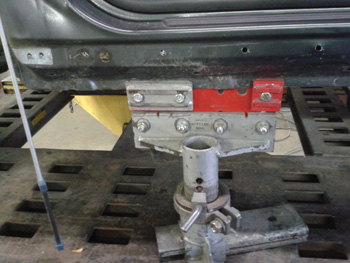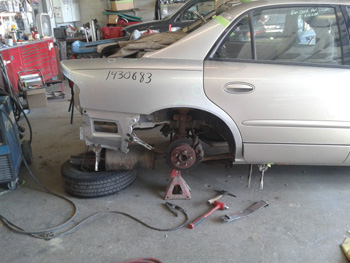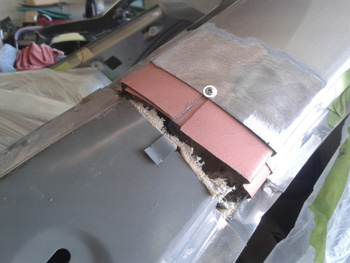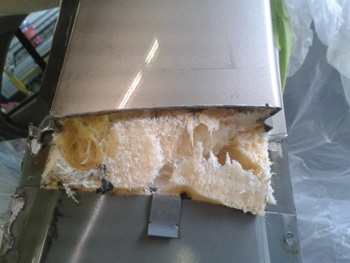When you work for a dealership body shop, you frequently have a particular make and model of vehicle coming in for repairs rather than a variety of makes and models.
Clamp Down

I work at a Buick GMC dealership, and we see a lot of Buick Enclaves and GMC Acadias. Same platform, similar body. These two models have 24 rocker molding clips on each molding. After you remove the moldings, the clamping technique is rather unique (photo 1). These vehicles sit higher than other passenger cars, so you have to use extended height clamps, which necessitates breaking down the clamps used for regular height vehicles and bolting on the height extension clamps for the Acadia and Enclave. Also, they have to be used in reverse, or tightened from underneath the vehicle as opposed to outside the vehicle, in order to avoid crushing the rocker drains.
Acadias’ and Enclaves’ need for special clamps is not unique. The Solstice/Sky platform and Corvettes also need them. Also, early-model Hondas had a vertical pinchweld that needed an additional clamp to be added to the horizontal clamps.
Whatever clamping system is required, if a changeover is necessary to properly lock down and secure the vehicle for pulling, document it with photos and charge for it.
Anchoring
Another additional and sometimes forgotten charge is what’s necessary to do a major correction on a frame. On a heavy hit, you may need additional anchoring points. This might be as simple as a chain or a cable wrapped around a crossmember, or even another tower attached to one of the stands for a stronger pull. Again, take photos and document your additional labor. Adjusters don’t try to be difficult; they simply have to answer to their superiors and justify why they authorized additional repairs and, more importantly, additional money. Photo documentation will tell your story and back you and your adjuster up.

Along with set-up, we have measuring (photo 2). Whether you use Arnwood gauges or a modern laser system, measuring is a necessary operation. Along with photo documentation, a printout of before and after specifications is even better. All computerized measuring systems are capable of a printout for your adjuster and your records. One nice feature on some systems is point-to-point measurement, which can verify a bent subframe before you get a nice surprise on the alignment rack. You can measure a lower ball joint to see if you need a lower control arm or the subframe mount bolts to determine if you need a subframe. This virtually eliminates the issue of performing two alignments because you catch all the damage up front.
An adjuster can’t argue with a printout. At the end of the day, you save yourself (and XYZ insurance company) because there were no surprises when it came time for a four-wheel alignment. This can make the difference between a Friday night delivery and an extra weekend of rental.
Used Parts

Now, I would like to address LKQ quarter panel assemblies (photo 3). I’ll be honest, I like installing them for a few reasons, the main one being that if you need the wheelhouse, it’s already welded on the quarter panel with factory (hopefully) welds. An often overlooked operation is time to inspect a used assembly, whether it be a door, fender or quarter cut. We’ve all been there.
The salvage yard wants to drop off the part. Your parts department will issue a P.O. and the driver leaves. The tech is told his parts are here, only to find out that it’s the wrong model, options or any number of different reasons why it’s unacceptable. Our main concern should be rust and previous repairs. My shop has had to reject several parts on the basis of rust and previous repairs. We need to inspect these used parts, and that takes time – time that we’re not repairing automobiles. Even a mere .5 might make the difference between a Friday afternoon delivery and another weekend of rental.

OK, we now have an acceptable used quarter panel assembly. Now it’s time to decide where to section and start drilling spot welds. I-CAR guidelines will direct you to manufacturer specifications as to where and if you can section. A general example would be a 25-millimeter backer in the sail panel and a 50-millimeter backer in the rocker panel. We used to call this a sleeve (photo 4). Fabrication of a sleeve is an extra operation. Insurers know it and will pay for it. If you’re not charging for it, start tomorrow. The carriers I work with never deny it.
Foam

What about foam (photo 5)? Flexible foam is expensive, and you normally use about one half of a cartridge on a typical quarter panel. And don’t forget removal because it’s flammable and must be taken out before welding.
I personally prefer to install used quarter panels with the wheelhouse because it leaves the factory spot welds intact on the quarter panel, but this process is not always possible. Some wheelhouses are integrated into the upper sail panel and they, in fact, become the inner wheelhouse/sail panel at some point.
This brings us to pre-assembly. I would never commit to welding a used assembly on without pre-assembling the deck lid, door and tail lamp on the side I’m replacing. I need to see the fit and gaps before I weld. Pre-assembly or mock-up is a necessary and valid operation. It takes time, and you might need to fit your quarter more than a few times to achieve an acceptable fit.
Funny Money
Insurance companies save a boatload of money by using LKQ parts. There would be no funny television commercials without money. There would be no Flo or Mayhem. That, my fellow technicians, is the money we saved them by not asking to be compensated for all the labor we do.
Recently, I had an experience with an adjuster from the company with the cute green lizard. We have no DRP agreement with this company. He was fair with his repair times, and all he asked was that we document additional damage so he could justify to his superiors why he authorized additional labor.
The money is there for the asking. Document your damage, and get paid for what you do. Flo and Mayhem don’t work for free, and neither should we!













